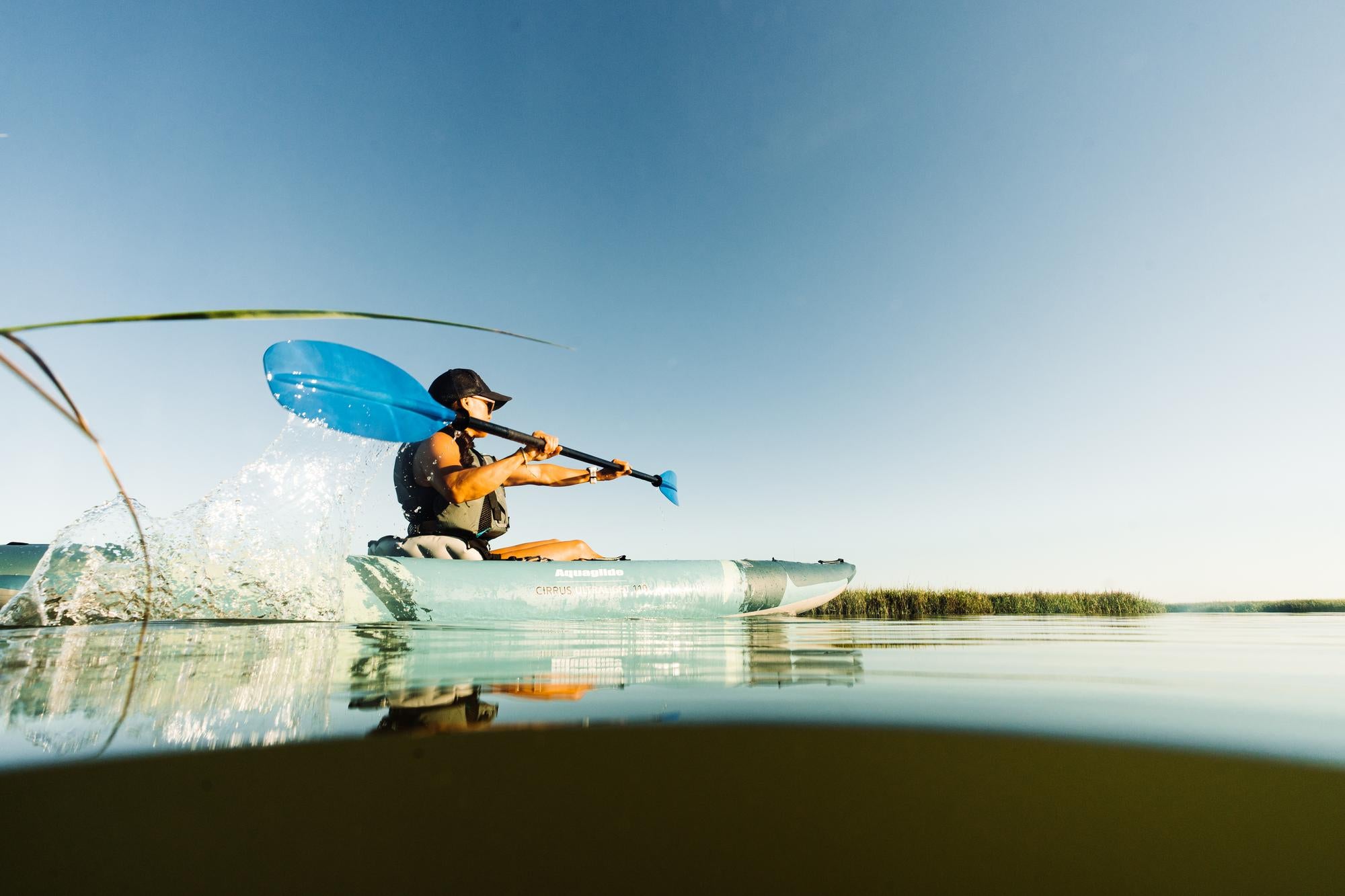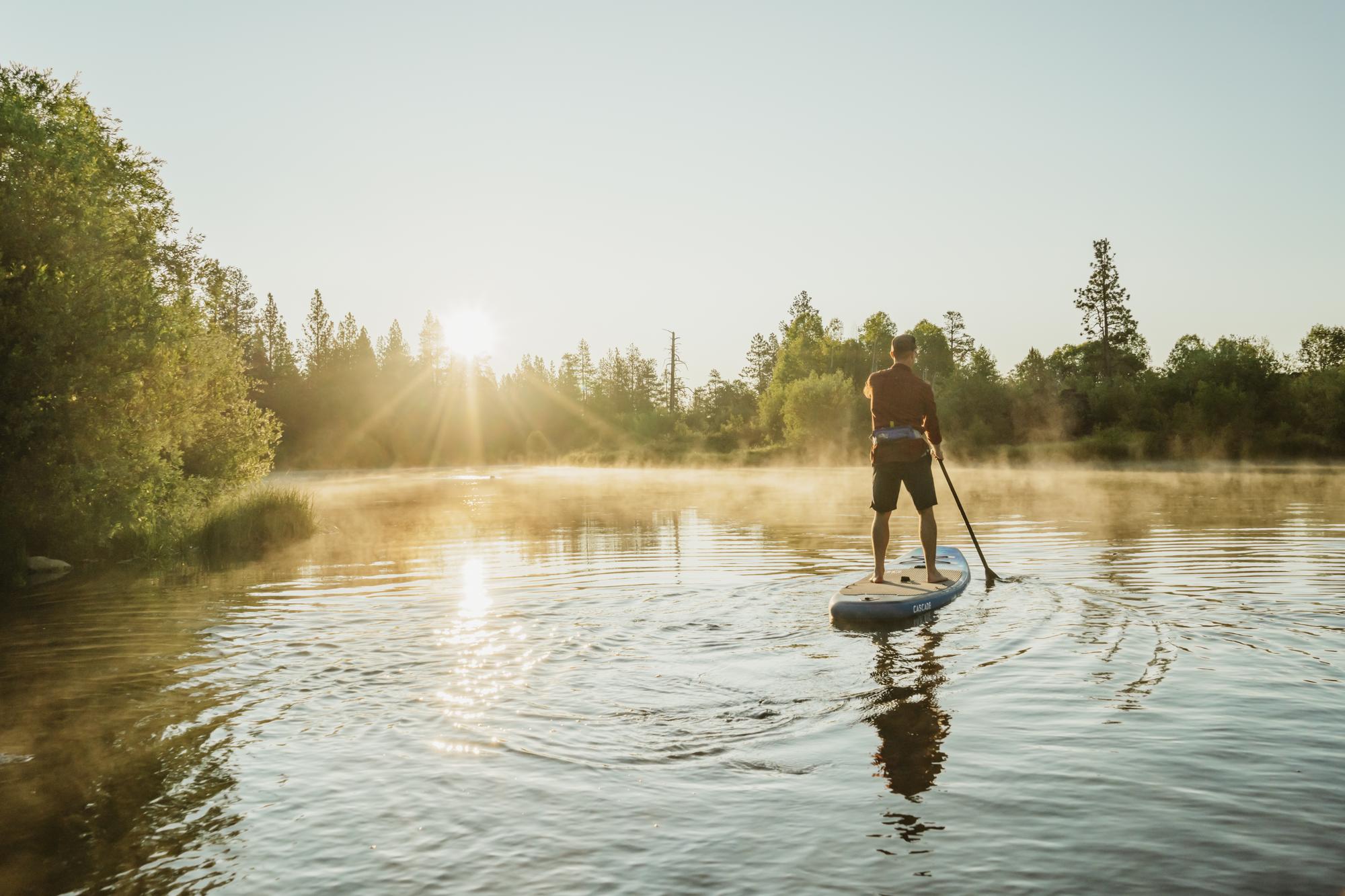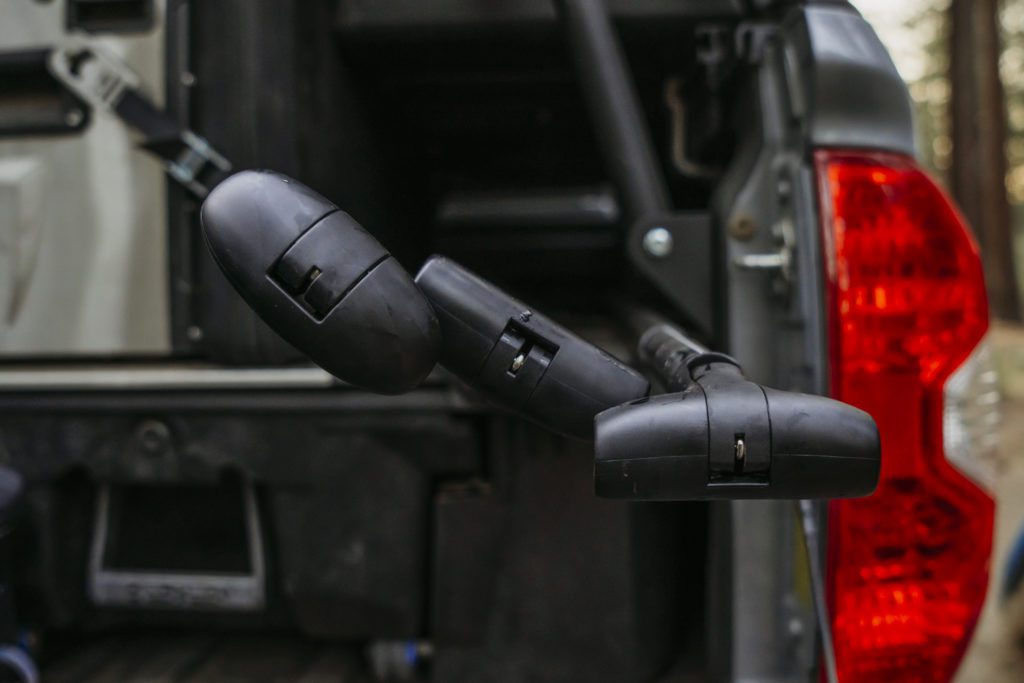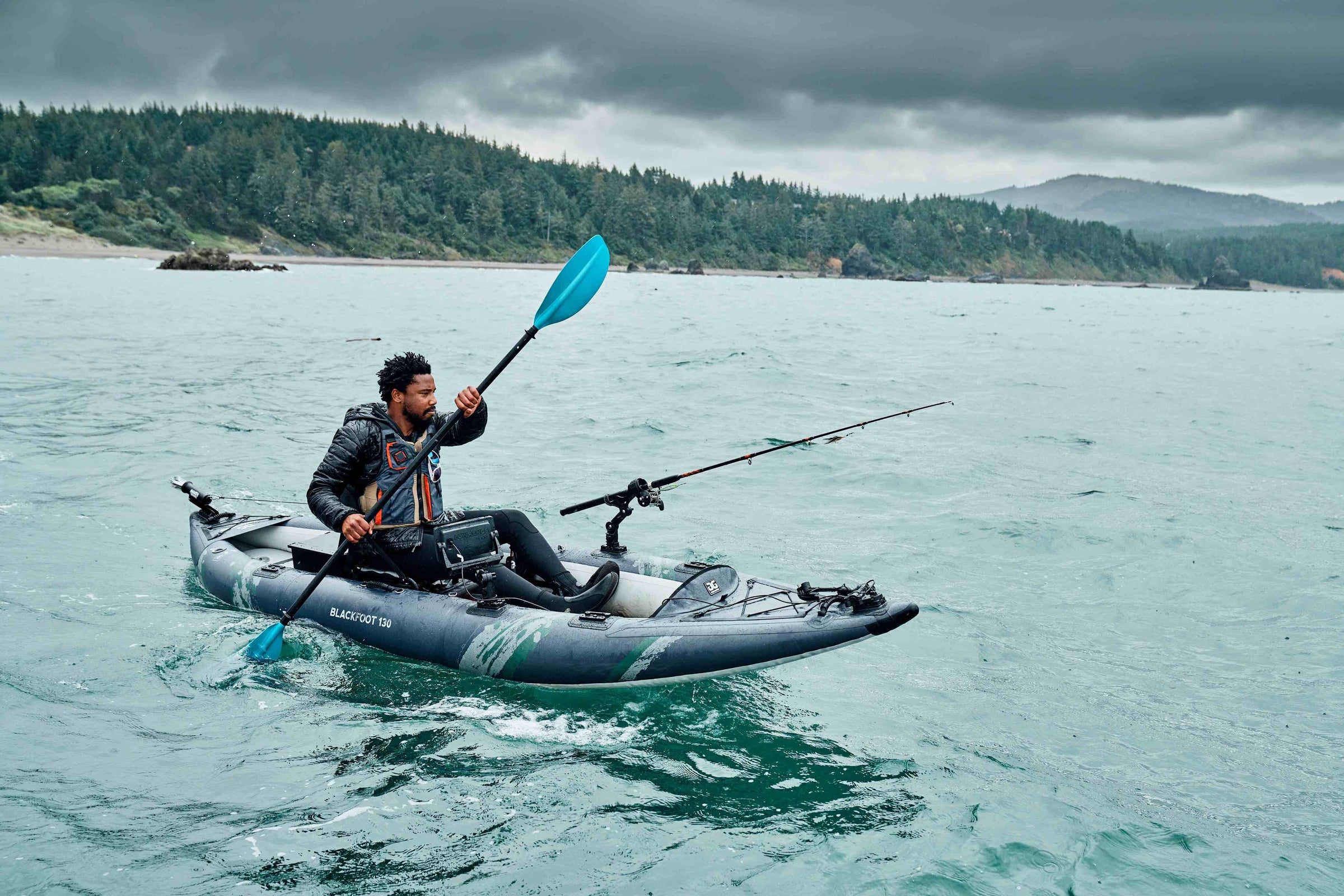SUP and Kayak
Aquaglide kayaks are lightweight, durable, portable, and performance-oriented. These attributes make them ideally suited for recreational paddling, touring and adventure travel. But with so many types of boats & boards, choosing the right one to fit your lifestyle can feel overwhelming.
STEP 1: Choose Function(s)
The first step to choosing a kayak is to determine what type of paddling you'd like to do. Most boats easily cover different types of paddling, but envisioning how you will use the boat can will help narrow the choices. Start by picking your top functional performance categories from the list below.
ANGLING - Nearly all Aquaglide kayaks are fishing-friendly, but we offer several models, such as the Blackfoot 160, with unique features and attributes that are especially well-suited for technical angling.
RECREATIONAL - Aquaglide Kayaks are all about fun on the water. To be fun in a wide range of conditions, boats like the Chinook 100 offer a well-balanced selection of attributes.
TOURING - Expand your adventures! Touring is all about going places. To accomplish that goal, boats like the Chelan 140 boats favor attributes like speed, tracking and comfort needed for longer outings.
WHITEWATER - What greater rush than finding the right line down a surging river? Whitewater boats such as the McKenzie 125 require a blend of stability, maneuverability and excellent drainage.
ULTRALIGHT – Ideally suited to the needs of mobile explorers and outdoor hunting and angling enthusiasts. For paddlers headed ‘off the grid,’ it has to be an ultralight such as the Purist 65.
STEP 2: Choose Size
The next step is to choose a size. Sizing is a very personal choice, again determined by how you intend to use the boat. Do you need room for two or even three people? Are you a solo paddler? Choosing the right boat means considering how much space you want for paddlers and for gear. A tall solo paddler may choose a two-person model for better leg-room. A solo touring paddler may prefer a tandem size for increased gear capacity and space for the occasional guest. Stepping up in size increases your options because Aquaglide seating can be easily re-configured to suit different needs.
STEP 3: Consider Attributes (optional)
If your choice is already made based on function and size, comparing attributes seem like an unnecessary detail. However, going a step beyond the general functionality and sizing of a boat to compare the specific attributes can help cinch the decision between two similar boats.
SPEED - How quickly the boat moves through the water.
TRACKING - How straight the boat travels while paddling.
STABILITY - How stable the boat is from side to side.
MANEUVERABILITY - How responsive the boat is to turning input.
GEAR CAPACITY – How much space is available for extra stuff.
DRAINAGE - How quickly does the boat drain in wet conditions.
Taking these factors into consideration should help you decide which Aquaglide kayak is best for you.
We are frequently asked for whitewater ratings on our boats. A few other inflatable brands rate their all-purpose recreational or even touring boats for whitewater use, so why doesn’t Aquaglide do the same? Are AG boats not capable of paddling whitewater?
To make a long answer short, as lifelong paddlers and boaters, we feel there is no substitute for experience when it comes to the water. In particular, whitewater is dangerous, variable and unpredictable. If you have the skill and experience to safely handle Class II or Class III whitewater, then you have the knowledge to assess whether or not a certain boat will be up to the task you’re considering. We don't label "ratings" of kayaks to avoid misleading customers by representing a boat designed for flatwater touring as ‘whitewater capable’ - even if it may be perfectly capable in the right hands.
We designed and tested McKenzie series (our whitewater specific kayaks) to be both stable and maneuverable – perfectly suited for novice to intermediate whitewater paddlers. We meticulously checked on points like sufficient rocker, adequate drainage, edges and other attributes that can keep a fun day from becoming a cold, dangerous swim. Then we rated even these proven whitewater designs very conservatively with a Class II rating. The McKenzie is an ideal choice for those looking to learn or expand their skills and knowledge into whitewater paddling.
Some of our other kayaks have features such as great drainage and excellent durability that one could argue makes them more than capable for limited types of whitewater use. However, we deliberately don’t rate them for whitewater because we feel it’s best to be clear about the design parameters and not mislead folks into a situation that could be potentially dangerous. We care about our customers and prefer to keep you safe!
For detailed descriptions of classes according to the International Scale of River Difficulty, explore the American Whitewater Safety Code.
So you’ve unboxed your brand new Aquaglide kayak or SUP, and see white marks on the material. What are those marks, and do they impact your new craft? Those marks are simply a phenomenon known as “marbling”, and are a frequent occurrence on supported PVC inflatable watercraft that have been tightly folded and packaged after production.
Rest assured that this marbling poses absolutely no threat to the structural integrity of your craft and typically disappears after just a few uses.
The process of inflating and deflating your kayak or SUP will naturally eliminate marbling relatively quickly. We also understand that you may wish to accelerate this process. If that is the case, careful application of heat will relax these marks away.
- Inflate your watercraft
- Using a heat gun, slowly heat up affected area(s) to relax the material
- While heating, frequently brush the palm of your hand across heated area, making sure that it does NOT get too hot to touch (as this is the point that you can damage the material)
- As material relaxes, you will see the white marks slowly disappear
There is the potential to overheat and damage your kayak or SUP using a heat gun, so we strongly recommend that you let the process of using your watercraft eliminate marbling naturally. Either way, we hope that this helps ease your mind and allows you to enjoy years of fun with your Aquaglide product.
Happy paddling!
While our kayaks and SUPs are not rated for traditional outboard motors, the rapidly evolving use of lightweight, electric trolling motors, ‘power fins’ and other E-drive propulsion has opened up many new possibilities for recreational boaters. As e-drives and other electric propulsion devices gain popularity, we’re often asked if it’s okay to use them on Aquaglide boats. The answer is yes – with a few caveats.
Not all of our boats can be used with propulsion – acceptable models are all Duratex kayaks (including all models of Deschutes, Chelan, McKenzie and Blackfoot produced since 2020 model year (HIN ending in …20 or greater)) and all SUP boards 2021 and newer. These models are approved for use with auxiliary propulsion up to a MAXIMUM 0.75 kW (0.90 hp – 70 pounds thrust).
There are two main options for mounting these propulsion devices. The first is via utilizing the standard US fin box that comes standard with these kayaks and SUPs. The second is by utilizing the Universal Mounts that come on some boats, such as the new (2021 and newer) Blackfoot series. We restrict our recommendation to Duratex boats, and do not typically recommend using E-drives that attach via cam straps because there are too many potential errors that can cause a bad day on the water.
We recommend checking laws and regulations for your local bodies of water. Some states and countries require boat registration when utilizing propulsion of any kind. If needed for registration, you can find a manufacturer’s assurance of propulsion compliance here. Remember, it is your responsibility to ensure compliance with all local, regional, state and federal requirements.
Kayaks and SUP’s are graceful craft, but let’s face it, there’s nothing graceful about transporting a full size kayak or SUP to the launch site in a breeze. Customers occasionally ask about using a boat cart to transport their kayak or SUP. Inflatable kayaks and iSUPs have the advantage of being fully portable – no roof racks required – and they are frequently lighter than their rotomolded siblings but whether or not a cart is necessary depends on a few factors unique to each paddler. Here are a few points to consider:
Distance between setup and launch locations – Aquaglide kayaks and SUPs can be transported in a robust backpack like the River Crossing Pack and inflated at the launch with an AG Kayak or SUP hand pump. However, many people who drive to the site prefer to setup their kayak or SUP near the vehicle so as to use a 12v electric pump for inflation. If the launch is nearby, perfect, but if there’s still a considerable hike to access the water, a cart might be a great investment. If you are close enough (and lucky enough!) to be able to setup at home and bike to the launch, a boat cart could be the best solution.
Type of terrain – Some types of terrain can be hazardous to navigate while carrying a kayak or SUP, and others, like steep hills or loose sand, might require all your energy to navigate while carrying a boat. A capable cart can be a lifesaver in conditions like this.
Space in the boat – A good cart will generally cost between $70 - $170, so it’s probably not something you want to leave on the beach while paddling. Keep in mind the space required to bring your cart with you. Some cart designs stow more compactly than others, and some boats offer less space than others, so it’s important to note this attribute when choosing a cart and to make sure there’s space in your boat to bring a cart along.
Cart Style – While there are a few boat-specific cart types like Plug-In Carts and End Carts, the most convenient and versatile type of cart for inflatable kayaks and SUPs are Strap Carts; basically a pair of wheels with a simple strap system for attaching the stern of your boat or board.
Materials – Carts with a steel frame are usually heavier and less costly. Aluminum frames are typically lighter and preferred around saltwater. Think about the places you intend to paddle and choose materials that best fit your needs. Asking other local paddlers for their preferences can yield good food for thought.
Wheels – Wide wheels are best for softer terrain but can be annoying with a long commute over hard ground. Tall, narrow wheels will roll with little effort and make bike commuting a joy but are likely to struggle in sand. Airless wheels are tough and durable but can be noisy on hard ground, while inflatable tires may require some extra care, including a patch kit and (sigh) yet another pump.
In the end, whether or not you need a boat cart depends on your style and paddling location. Although not strictly necessary with eminently portable inflatable kayaks and SUPs, some paddlers wouldn’t consider heading out without a good boat cart. Hopefully the points above will offer a few good points to consider when making the choice.
Feathering is where the blade angles are offset instead of aligned at the same angle. It is sometimes used to reduce effort when paddling into strong winds, as well as to reduce wrist strain. All AG kayak paddles have a feathering capabilities to various degrees. Feathering angle is a strongly personal preference, and we encourage trying out various feather angles to find what works best for your paddling style.
AG Orion paddle feathering is infinitely adjustable using Leverlock, while all other AG models have preset feathering angles at +/- 60 degrees. These are the 3 offset holes found near the center of the shaft on all other models. Without feathering, the paddle is assembled in the center hole. With feathering, the paddle is assembled in the forward (+60 degrees) hole, or the backward (- 60 degrees) hole.
To use feathering, which involves rotating the paddle with each stroke, it's necessary to have an index for the paddlers primary hand. The black wrap on paddlers right hand side of AG paddles is not a grip, but is there to hold the index in place. The index is a slightly ovalized shaft profile at 90 degrees to the paddle blade indicating when the primary (right hand) blade is angled at 90 degrees to the water.
NOTE: The following instructions are for patching a basic leak on a PVC inflatable, typically a puncture or cut. More complicated repairs such as those near seams and corners, may require special repair techniques. If so, please contact Aquaglide for additional instructions.
Helpful items and where to find them:
Solvent - Don’t skip the solvent. It’s important to clean surfaces with solvent before making a long-lasting repair. MEK (methyl ethyl ketone) is the best solvent for PVC repairs, but acetone will also work. Rubbing alcohol or alcohol wipes (for traveling & med kits) work in a pinch, but is not nearly as good at removing oils on the surface that will spoil adhesion. In North America, all of these products can be found online and at local hardware or home repair stores.
Miscellaneous - For Tear-Aid or Reinforced patch you will need sharp scissors or a razor knife, a bit of sandpaper (medium grit), pencil or china marker. A clean rag is helpful for any repair. You may also want liquid dish soap & sponge (to find a sneaky leak), and a respirator and gloves (to keep the solvent away from you).
Tear-Aid – Tear-Aid Type B is a self-adhesive patch material that’s widely available online and at nationwide retail outlets like Walmart, Ace Hardware, REI and more. Great for relatively long-term repair of punctures on all types of PVC products. Clear, non-toxic and easy to use.
Aquaseal FD – This is a liquid sealant that can be oozed into very small cracks, edges and pinholes. Widely available online and at nationwide retail outlets like Walmart, West Marine, REI and more. This stuff is a little messy to work with and may be best applied using a small plastic irrigation syringe from the drug or hardware store.
Shoe Goo, Clear – Yup, seriously. This is a very thick vinyl-based adhesive that can be used for quick, short-term plugging of small holes on low pressure items. Widely available online and at nationwide retail outlets like Walmart, Lowes, Walgreens, Dick’s, REI and more.
Fabric Reinforced PVC – Reinforced PVC, or tarpaulin, is commercial grade material that is the basis for most of Aquaglide’s Duratex products. The strongest and most durable repair for Duratex items is generally to patch with material of the same type. This material can be found in the repair kit included with your Aquaglide product or purchased from an Aquaglide distributor. In a pinch, similar material can be found online, or at marine stores where RIB dinghies or whitewater rafts are sold or serviced. If you go this route, DO NOT to use patch material or glue intended for Hypalon, which looks almost identical, but will result in a gooey mess when combined with PVC.
Contact Adhesive - For those choosing to repair with a reinforced PVC patch, using good glue is critical. We recommend and HH-66 vinyl adhesive, which is available through Aquaglide, and also widely available online, through Walmart and many local auto parts stores where it is used to adhere auto emblems. The 4oz and 8oz sizes typically have an applicator brush in the cap – perfect! If not, you’ll need a small disposable brush.
Under normal conditions of storage and use, reinforced PVC product life span is 5 - 10 years. Extreme, high-volume commercial use may reduce expected life span, however, proper maintenance, cleaning and repair can certainly extend life span. See the product Owner’s manual(s) for details.
Even after you’ve done everything possible to extend the life of your product, it will eventually reach a point where it can no longer continue to serve its intended purpose. Below are a few disposal options.
Upcycling/ Recycling: Upcycling, also known as creative reuse, is the process of transforming by-products and discarded materials into new products, thereby extending and enhancing the value of the material. Reinforced PVC is extremely durable material which offers the benefit of being strong, rugged and waterproof. There are many upcycling options available. Search social media platforms to tap into great creative ideas and potential material demand. There are also groups such as TerraCycle (www.terracycle.com) that can help find sustainable options for upcycling/recycling of reinforced PVC material.
Mechanical recycling: Our 4P reinforced PVC may be mechanically recycled in regions with the proper recycling facilities.
Incineration/ energy recovery: Our 4P PVC may be utilized for energy in regions with the proper energy recovery facilities. Incineration should be performed only by a certified facility licensed to incinerate thermoplastic polymers. Do not attempt to DIY.
Landfill: When other options are not available and disposal in a landfill is necessary, disposal should be done in accordance with all applicable national, regional and local laws and regulations. Disposal in this manner poses no known human, ecological, or toxicological hazards, but is not a sustainable practice.
Accessories
The Accelerator Pump is a 2-Stage pump that automatically switches between the stages during inflation. The switch is quite distinct because the pump changes to a different internal motor as a normal part of its operation. This typically happens somewhere between 1.0 – 2.0psi.
During normal operation, after providing power to the pump and setting the pump to your desired working pressure, a brief touch of the power button will begin the pump motor in stage 1. The pump's 'volume' stage motor (stage 1) makes a high-pitched whine that sounds a bit like a vacuum cleaner. In stage 1 the pump will push as much air as possible until the air pressure gets to about 1.2 psi. Above this point, the pump will automatically change to its ‘pressure’ stage motor (stage 2), which sounds more like a small combustion engine with a cylinder. The pump determines it’s time to make the switch to stage 2 when it’s making no progress at all in stage 1. This process may take a minute or so while progress is slowing. Although the stage 2 motor moves less air, it does so more powerfully, so it has the ability to reach pressures up to 20.0psi. Inflation progress will gradually slow as the pump reaches the upper limits of its range.
If you are standing nearby as the stage 1 progress begins to slow (~1.2 – 1.5 psi), you can save some time by forcing the pump into stage 2 (pressure) mode. Do this at any time during inflation by holding the power button down again for 3 seconds. Unless already operating in stage 2 mode, you should hear a distinct change in the sound of the pump as it changes over to stage 2.
All 2021 Blackfoot Angler models come standard with the AG Frame Seat, and as they are compatible with most Aquaglide SUPs, many others are buying these plush seats for an upgrade. We've heard concerns regarding the rubber feet used to protect inflatable dropstitch floors from the otherwise potentially damaging aluminum frame in the “low” seat setting, and want to share some pro-tips for keeping you on the water. One thing is for certain, using the seat in low setting without these rubber feet can cause damage! In a pinch, use the high setting until you can get things sorted. A few points:
Keep it inflated. It’s easier on the rubber feet if they don’t have to conform to overly soft floors, so your best bet (and best performance) is to keep floors inflated to their specified working pressure (6.0psi for kayaks).
Use the Spares. Aquaglide has included 4 spare feet with each Frame Seat. If you experienced rapid wear on the first set, see below to extend the life of these extra rubber feet.
Extend the life. To disperse the weight load, insert fender washers into the bottom of the rubber feet. For most applications, simple zinc plated fender washers are large and flat and will do just fine. For daily saltwater use we’d suggest stainless steel. Sizing for the washers is key: Metric washers should have a 5mm – 8mm hole with OD = 22.0mm. Imperial washers should be #10 sized (0.20”) hole with an OD = 7/8”. These are commonly available at hardware stores – typically less than $0.50 for 4. For a visual representation of what this looks like, view this PDF.
Use a rubber floor mat. This is something you shouldn’t have to do. Following the advice above will help avoid this, but one paddler told us he likes this option best to keep his floors clean. To each his own!
With these pro-tips, your frame seat will keep you on the water in comfort. Worst case scenario, you can contact Aquaglide for replacement rubber feet, or find them easily at most hardware stores or online. Please feel free to reach out to us with any comments or concerns!
Many AG products are fitted with Universal Mount plates designed to fit a wide range of aftermarket accessories including AG Cupholder (sold separately).
Mounting screws should be ¼-20 size and Stainless Steel (either #304 or #316 SS alloys work and are widely available). Screw length required can vary between ¾” (19mm) and 1” (25mm) in length depending on the type of accessory being mounted to it. The screw head required can also vary between pan head and countersunk depending on the accessory.
Please be careful not to over-tighten mounting screws on the Universal Mount. If using common mounts, 1” length mounting screws generally fit perfectly, however, for non-standard mounts, different length screws may be required. To prevent overset screws, which can easily puncture the boat, the threaded mounts terminate in welded backing plates. The mounting threads allow approximately ¼” (7mm) depth before the mounting screw will bottom out on the backing plate. Do not force-tighten mounting screws. If overtightened, mounting plate nuts can be stripped, requiring replacement of the entire plate. What kind of accessories can I add with Universal Mount?
Here are some of our favorite accessories...
- Lowrance HOOK Reveal 7x SplitShot with CHIRP, DownScan & GPS Plotter
- YakAttack Rectangular Fish Finder Mount (7”)
- YakAttack SwitchBlade™ Transducer Deployment Arm
- YakAttack 10Ah Battery Power Kit
- YakAttack GT Cleat XL
- Scotty #55 Bait Board
- Scotty #152 Ball Mounting System with Gear-Head Adaptor and Control Arm
- Anchor Wizard Kayak Anchoring System
- YakAttack Mighty Mount Switch (mini track)
- YakAttack RotoGrip™ Paddle Holder
- YakAttack CommandStand™ Universal Stand Assist Bar
- YakAttack Omega Pro™ Rod Holder
- AG Cupholder
- Brocraft Trolling Motor Mount





